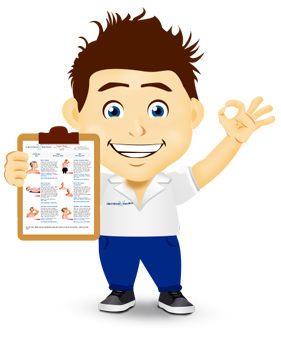
Next steps:
Feel free to read the advice sheet below! To get the full benefit click on 'Start treatment'. By starting the treatment you will get access to weekly rehab programmes online for FREE. You will be able to track your progress, pain levels and we will remind you to do your exercises every day!
The back is composed of a number of vertebrae that make up the lower back (lumbar spine) and the upper back (thoracic spine). As lower back pain is much more common than upper back pain, we will focus on lower back pain, but the principles of treatment apply to both the upper and lower back.
The vertebrae are stacks of bone surrounded by muscles and ligaments, and they provide the spine with stability. These muscles provide you with motion and support. The lumbar spine articulates with the sacrum, which joins the pelvis, and the nerves going to the legs come from the lumbar spine. For many individuals, pain in the back is temporary and goes away within 2-4 weeks. Other individuals require treatment to alleviate symptoms and pain. Some people suffer with chronic back problems that last years.
What Causes Back Pain?
There are many causes of back pain. The best way to discuss the possible causes are to discuss the structures:
Facet joint:
Facet joints are pairs of joints that occur at every spinal level, so in the lower back there are 10 of them. They can be strained or injured, or simply become stiff/locked and inflamed. Facet joint syndrome is a very common back problem. The facet joints can become inflamed and stiff which causes excruciating pain just to the left or right of centre of the back, or across the base of the spine at both sides.
Muscle:
Muscle pains in the back are common and usually result from fatigue or muscle aching. They are almost always caused by poor posture. The problem is that we tend to do a lot of forward bending. We sit at work all day, we go home and sit on the sofa, we bend to look after our children, and to pick things up. But we rarely extend or arch our backs. So small muscles need to support a lot of weight when we are forward bending. After a few months fatigue and cause muscle aching and back pain.
Disc:
There are five lumbar discs (L1/2, L2/3, L3/4, L4/5, L5/S1). These are susceptible to disc bulges, prolapses, or herniation. Basically known as a “slipped disc” in lay terms, the disc protrudes backwards and can pinch a nerve in the back causing pain to travel down the arm. It is very common, and becoming increasingly prevalent due to repetitive forward back bending.
Vertebrae:
The vertebrae and facet joints (and discs) are always susceptible to wear and tear, or osteo-arthritis. It is very common in older age, and can simply just be the normal aging process. However, sometimes the inflammation associated with the condition can flare up and cause patients to suffer a lot of pain. This condition is best diagnosed by checking back movement, with sufferers having a particularly stiff back. It also tends to run in families, so if you had a parent with osteo-arthritis there is more chance you will get it too.
Ligaments:
Ligaments are less commonly injured, but can be damaged with forceful movement to the back such as car accidents, or sports injuries.
Precautions
If you are experience any of following symptoms consult your GP or other healthcare profession as soon as possible.
- Pins and needles in hands and/or feet.
- Difficulty walking, weakness in legs.
- Disturbance of bladder and bowel function.
- Numbness around the groin area.
What you can do
You can do the following things to help you to manage your back pain and aid recovery.
- Stay active: Gradually start to increase your normal daily activity can help to reduce your stiffness and pain and improve physical function. Cycling and swimming are generally recommended as safe for back pain sufferers.

- Medication: Taking anti-inflammatory and analgesics as directed by your GP in the acute stage. Good pain relief will allow you to remain active, and this will speed up recovery. This is best for short term use.
- Posture: Change activities and position frequently, every 20-30mins. Lying, sitting, standing or walking for too long may cause stiffness and discomfort. This should improve with time.
- Heat/Ice: Applying Ice to you back in the first 3-5 days will help to reduce swelling and pain. Wrap ice or frozen peas in a towel before applying. Apply heat thereafter to help ease muscle spasm, joint stiffness and aid the healing process. Use a hot water bottle, wrapping it in a towel before applying, alternatively have a hot bath. Applying for 15-20mins and use regularly.

- Sleep: You may have difficulty sleeping. Usually a supportive mattress and one pillow will improve you comfort. Do not sleep in a chair on the floor. Try placing pillow under knee if sleeping on your back or between your legs if sleeping on your side.

- Regular stretching exercises; Pilates, Yoga, or home stretching: Performing regular stretching and strengthening exercises to your back can improve posture, reduce pain and reduce muscle fatigue. Follow the advice from your therapist.

- See a Physio, Osteopath, Chiropractor or Manual therapst: see a recommended therapist to help improve your back pain. Ask your doctor for a referral. Only go to see a trusted rehabilitation expert.

